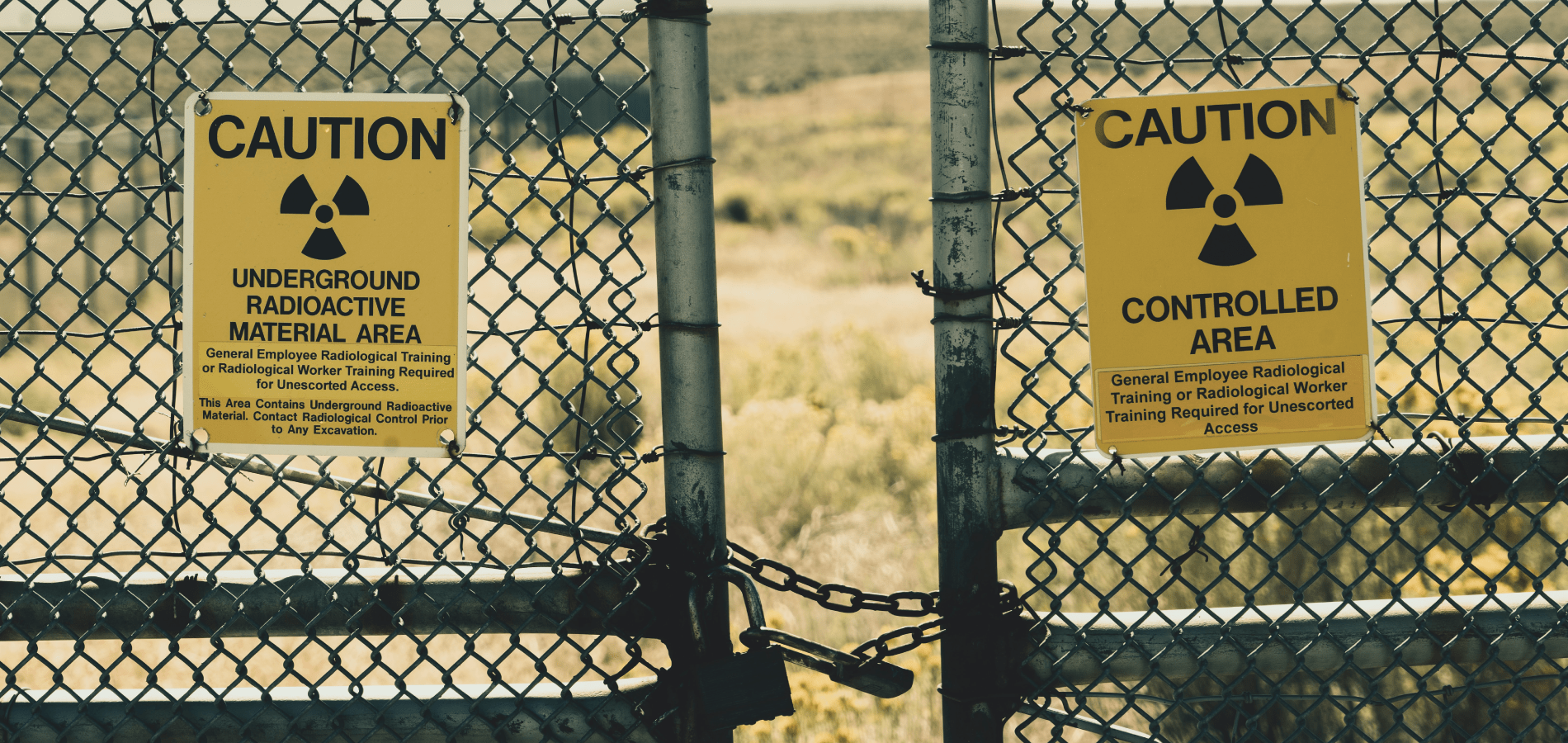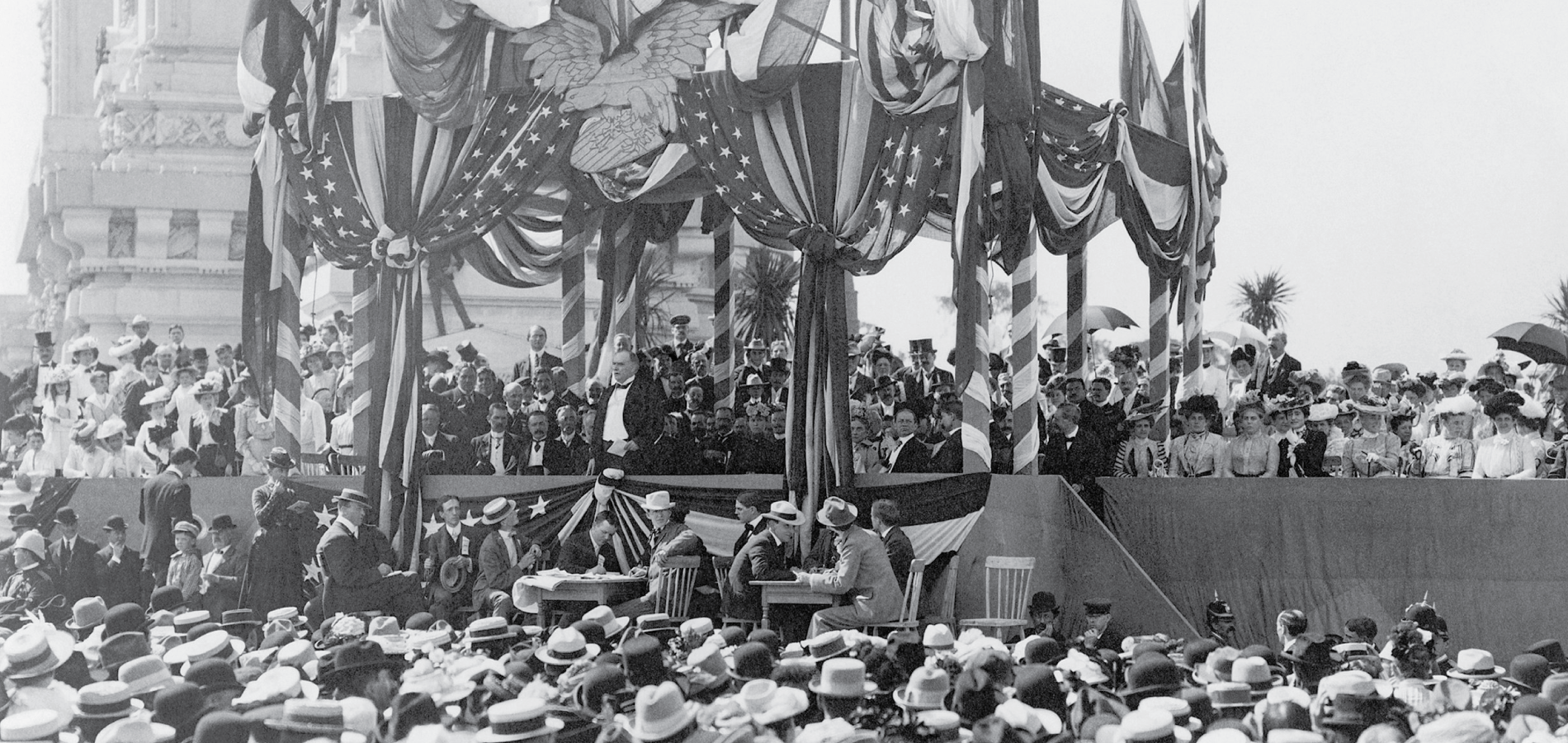As we enter year three of the COVID-19 pandemic, we’re utilizing this month’s Secrets of the Serial Set post to delve into the history of another disease that spread across the world, including the United States, during the 1980s–AIDS, or autoimmune deficiency syndrome.
The First Human Cases
According to the Centers for Disease Control (CDC), HIV (human immunodeficiency virus) likely first developed in humans when hunters in Central Africa came into contact with the blood of chimps infected with SIV, or simian immunodeficiency virus. Then, the virus spread throughout Africa along trade routes, eventually making its way to Haiti, and then to New York City and San Francisco. Scientists have determined that HIV officially made its way to the United States in 1970, but it wasn’t on the public’s radar until the early 1980s.
In the spring of 1981, a couple of outbreaks among gay men of rare diseases, Kaposi’s sarcoma and Pneumocystis carinii pneumonia,[1]“Federal response to AIDS.” U.S. Congressional Serial Set,1983, p. 1-VI. HeinOnline, https://heinonline.org/HOL/P?h=hein.usccsset/usconset20471&i=1408. This report can be found in HeinOnline’s U.S. Congressional … Continue reading were reported to the CDC. Now, it is known that these diseases are opportunistic infections caused by AIDS. At the time, there was no cure for AIDS. Eighty-nine percent of those with AIDS in 1980 died. As of 1983, there was a 40% mortality rate associated with AIDS.[2]“Federal response to AIDS.” U.S. Congressional Serial Set,1983, p. 1-VI. HeinOnline, https://heinonline.org/HOL/P?h=hein.usccsset/usconset20471&i=1408. This report can be found in HeinOnline’s U.S. Congressional … Continue reading
AIDS and Homophobia
During the early 1980s, the majority of people with AIDS were gay and bisexual men or intravenous drug users—leading to much misunderstanding of the disease and discrimination against these populations. Articles began to be published about the compromised immune systems of growing numbers of gay men, further leading to stigmatization of the LGBT community as well as misinformation about AIDS, which was nicknamed the “gay plague.”
In fact, in May 1982 The New York Times published an article using the term “Gay-Related Immune Deficiency” (GRID). It wasn’t until that September that the CDC used the term AIDS for the first time, and it wasn’t until 1983 that HIV was identified as the virus that causes AIDS. However, even as women and straight people began to be diagnosed, it remained a prevalent belief that AIDS was a gay man’s disease. In 1983, the CDC suggested that AIDS was most likely spread by sexual contact and exposure to blood of infected individuals.
Government Response—or Lack Thereof
Today, it is widely recognized that federal government response in the United States to combat and control AIDS was lacking. For example, a report in 1983 indicated that “Recent cutbacks in health funding and the elimination of many categorical health programs, however, have limited the flexibility and funding options that were available to the PHS in the AIDS crisis.”[3]“Federal response to AIDS.” U.S. Congressional Serial Set, 1983, p. 1-VI. HeinOnline, https://heinonline.org/HOL/P?h=hein.usccsset/usconset20471&i=1410. This report can be found in HeinOnline’s U.S. Congressional … Continue reading In fact, a CDC official even noted, “As additional CDC funds were not available, the mobilization of staff and other resources for AIDS meant sacrificing other important disease control programs.”[4]“Federal response to AIDS.” U.S. Congressional Serial Set, 1983, p. 1-VI. HeinOnline, https://heinonline.org/HOL/P?h=hein.usccsset/usconset20471&i=1410. This report can be found in HeinOnline’s U.S. Congressional … Continue reading
Below is a chart outlining HHS official figures for AIDS expenditures in the fiscal year 1983,[5]“Federal response to AIDS.” U.S. Congressional Serial Set, 1983, p. 1-VI. HeinOnline, https://heinonline.org/HOL/P?h=hein.usccsset/usconset20471&i=1414. This report can be found in HeinOnline’s U.S. Congressional … Continue reading a large part of which had to be pulled from other health needs:
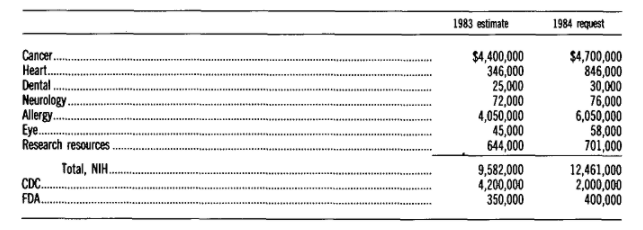
In addition, CDC’s Coordinator for AIDS laboratory activities[6]“Federal response to AIDS.” U.S. Congressional Serial Set, 1983, p. 1-VI. HeinOnline, https://heinonline.org/HOL/P?h=hein.usccsset/usconset20471&i=1415. This report can be found in HeinOnline’s U.S. Congressional … Continue reading wrote: “The outbreak of AIDS is a huge public health problem which requires a massive infusion of resources. The number of people already killed is large and all indications are that this disease will not stop until thousands of Americans have died. . . .Our government’s response to this disaster has been far too little. . . .The inadequate funding to date has seriously restricted our work and has presumably deepened the invasion of this disease into the American population.” In 1984, Congress allocated a total of $12 million to the CDC and NIH[7]“Department of Labor, Health and Human Services, and Education, and related agencies appropriation bill, 1984.” U.S. Congressional Serial Set, 1983, p. 1-IV. HeinOnline, … Continue reading to combat AIDS.
But even into the late 1980s, the government still wasn’t providing adequate funding for AIDS services. It wasn’t even until 1985 that then-President Ronald Reagan first publicly mentioned AIDS, and he didn’t give a public speech about it until 1987.[8]Ronald Reagan, Radio Address on Drug Abuse and Trafficking – May 30, 1987, 1987 Pub. Paper 582 (1987). This speech can be found in HeinOnline’s U.S. Presidential Library. In that same year, Congress banned the use of federal money for AIDS campaigns that promoted “homosexual activity.”[9]Legislative History of the Health Omnibus Programs Extension of 1988 P.L. 100-607 (1988). This Record can be found in HeinOnline’s U.S. Federal Legislative History Library. As the epidemic continued—by 1990 the CDC estimated that there were between one and 1.5 million people infected with HIV[10]“AIDS treatment and care, who cares.” U.S. Congressional Serial Set, 1990, p. I-54. HeinOnline, https://heinonline.org/HOL/P?h=hein.usccsset/usconset14017&i=325. This report can be found in HeinOnline’s U.S. … Continue reading—criticisms against the federal government and the United States healthcare system continued to grow.
Both of the following excerpts are pulled from a report titled “AIDS Treatment and Care: Who Cares?” located in HeinOnline’s U.S. Congressional Serial Set database:


“America Responds to AIDS”
By 1992, 1 million Americans had HIV, with deaths projected at 285,000 to 340,000 through 1993.[11]“Politics of AIDS prevention: Science takes time out.” U.S. Congressional Serial Set,1992, p. I-26. HeinOnline, https://heinonline.org/HOL/P?h=hein.usccsset/usconset14143&i=156. This report can be found in … Continue reading Health care organizations were still struggling with lack of funding. In fact, Dr. Donald P. Francis, a former senior official at CDC, wrote:[12]“Politics of AIDS prevention: Science takes time out.” U.S. Congressional Serial Set, , 1992, p. I-26. HeinOnline, https://heinonline.org/HOL/P?h=hein.usccsset/usconset14143&i=158. This report can be found in … Continue reading “Much of the HIV/AIDS epidemic was and continues to be preventable. But because of active obstruction of logical policy, active resistance to essential funding and active interference with scientifically-designed programs, the Executive Branch of this country has caused untold hardship, misery and expense to the American public. Its effect with AIDS will stand as a huge scar in American history, a shame to our nation and an international disgrace.”
Part of this lack of response was due to the conservativism of the Reagan and Bush administrations. In March 1992 (after more than a decade of infections and deaths), the federal government launched the “America Responds to AIDS” public education campaign.[13]“Politics of AIDS prevention: Science takes time out.” U.S. Congressional Serial Set, 1992, p. I-26. HeinOnline, https://heinonline.org/HOL/P?h=hein.usccsset/usconset14143&i=162. This report can be found in … Continue reading However, none of the approved advertising discussed the role of condoms or clean needles in preventing AIDS. The administration opposed condom distribution and needle exchange programs.
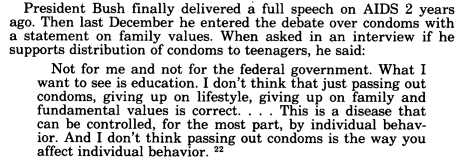
The lack of government response prompted several protests by ACT UP, the AIDS Coalition to Unleash Power. In 1992, thousands of protesters marched to the White House, many of them bringing the ashes of their loved ones who had died from AIDS, and dumped their ashes on the lawn.
Attempts at Protections
In 1987, AZT was approved by the FDA to treat AIDS.[14]“AIDS treatment and care, who cares.” U.S. Congressional Serial Set, 1990, p. I-54. HeinOnline, https://heinonline.org/HOL/P?h=hein.usccsset/usconset14017&i=329. This report can be found in HeinOnline’s U.S. … Continue reading Due to its intense side effects, in 1990 the FDA reduced the recommended dose by half. However, the drug was revolutionary in its ability to help slow the progression of HIV into AIDS. It also helps protect patients from opportunistic infections while decreasing their blood viral load, thus helping to prevent transmission of HIV from infected mothers to their fetuses.
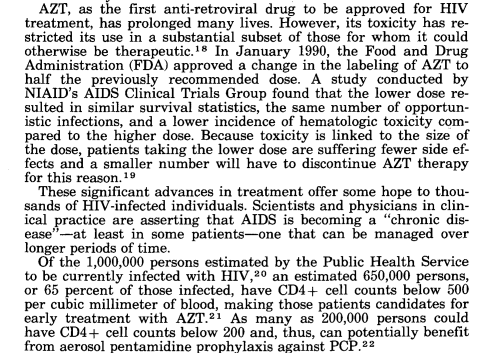
It wasn’t until 1990 that George H.W. Bush gave his first (and only) speech regarding AIDS.[15]George H. W. Bush, Remarks at the United States Olympic Committee Dinner – March 28, 1990, 1990 Pub. Papers 429 (1990). This speech can be found in HeinOnline’s U.S. Presidential Library. He proceeded to sign the Americans with Disabilities Act of 1990[16]To establish a clear and comprehensive prohibition of discrimination on the basis of disability., Public Law 101-336, 101 Congress. 104 Stat. 327 (1990). This act is located in HeinOnline’s U.S. Statutes at Large database. in an effort to protect people with HIV/AIDS and other disabilities from discrimination, providing them with federal civil rights protection. In addition, he also passed the Ryan White Comprehensive AIDS Resources Emergency Act[17]To amend the Public Health Service Act to provide grants to improve the quality and availability of care for individuals and families with HIV disease, and for other purposes., Public Law 101-381, 101 Congress. 104 Stat. 576 (1990). This act is … Continue reading to help fund AIDS treatment. But it was too little too late, as case numbers continued to grow, and people with AIDS continued to die in astounding numbers. In 1992, AIDS became the leading cause of death for American men ages 25-44, eventually becoming the leading cause of death for all Americans ages 25-44 by 1994. Cases wouldn’t begin declining until 1996.
AIDS Today
According to the CDC, nearly 1.2 million Americans have HIV today. While it is no longer an epidemic in the United States, AIDS still runs rampant in many African countries—55% of HIV cases are in eastern and southern Africa, with another 13% in western and central Africa. Stigma against those with AIDS has marginally improved—in 2009, then-President Obama lifted the ban implemented by Reagan preventing HIV+ people from entering the United States, as well as ended a ban on providing federal funding for needle-sharing programs.[18]“2010 National Drug Control Strategy.” U.S. Congressional Serial Set, 2010, p. i-110. HeinOnline, https://heinonline.org/HOL/P?h=hein.usccsset/usconset22805&i=620. This report can be found in HeinOnline’s U.S. … Continue reading The United States continues to provide funding to help eradicate AIDS nationally and in other countries. However, it will take a concentrated global effort to combat the AIDS epidemic and provide the services and education needed to treat and prevent this disease and end discrimination.
Help Us Complete the Project
Secrets of the Serial Set is an exciting and informative blog series from HeinOnline dedicated to unveiling the wealth of American history found in the United States Congressional Serial Set. Documents from additional HeinOnline databases have been incorporated to supplement research materials for non-U.S. related events discussed.
These posts have been so informative; they enable both patrons and staff to understand what the Serial Set is and how invaluable it is to all kinds of research.
The U.S. Congressional Serial Set is considered an essential publication for studying American history. Spanning more than two centuries with more than 17,000 bound volumes, the records in this series include House and Senate documents, House and Senate reports, and much more. The Serial Set began publication in 1817 with the 15th Congress, 1st session. U.S. congressional documents prior to 1817 are published as the American State Papers.
The Serial Set is an ongoing project in HeinOnline, with the goal of adding approximately four million pages each year until the archive is completed. To date, we’ve completed 95% of the project! View the current status of HeinOnline’s Serial Set project below.
If your library holds all or part of the Serial Set, and you are willing to assist us, please contact Shannon Hein at 716-882-2600 or shein@wshein.com. HeinOnline would like to give special thanks to the following libraries for their generous contributions which have resulted in the steady growth of HeinOnline’s U.S. Congressional Serial Set.
- Wayne State University
- University of Utah
- UC Hastings
- University of Montana
- Law Library of Louisiana
- George Washington University
- University of Delaware
- Southern Illinois University, Morris Library
We will continue to need help from the library community to complete this project. For a complete list of remaining missing volumes of the Serial Set, please email our Marketing Team at marketing@wshein.com.
Interested in Further Research?
To learn more about pandemics, vaccinations, and other related topics, be sure to check out our COVID-19: Pandemics Past and Present database, which now features a subcollection dedicated exclusively to the history of vaccinations for various diseases.
HeinOnline Sources[+]
| ↑1, ↑2 | “Federal response to AIDS.” U.S. Congressional Serial Set,1983, p. 1-VI. HeinOnline, https://heinonline.org/HOL/P?h=hein.usccsset/usconset20471&i=1408. This report can be found in HeinOnline’s U.S. Congressional Serial Set database. |
|---|---|
| ↑3, ↑4 | “Federal response to AIDS.” U.S. Congressional Serial Set, 1983, p. 1-VI. HeinOnline, https://heinonline.org/HOL/P?h=hein.usccsset/usconset20471&i=1410. This report can be found in HeinOnline’s U.S. Congressional Serial Set database. |
| ↑5 | “Federal response to AIDS.” U.S. Congressional Serial Set, 1983, p. 1-VI. HeinOnline, https://heinonline.org/HOL/P?h=hein.usccsset/usconset20471&i=1414. This report can be found in HeinOnline’s U.S. Congressional Serial Set database. |
| ↑6 | “Federal response to AIDS.” U.S. Congressional Serial Set, 1983, p. 1-VI. HeinOnline, https://heinonline.org/HOL/P?h=hein.usccsset/usconset20471&i=1415. This report can be found in HeinOnline’s U.S. Congressional Serial Set database. |
| ↑7 | “Department of Labor, Health and Human Services, and Education, and related agencies appropriation bill, 1984.” U.S. Congressional Serial Set, 1983, p. 1-IV. HeinOnline, https://heinonline.org/HOL/P?h=hein.usccsset/usconset20467&i=472. This report can be found in HeinOnline’s U.S. Congressional Serial Set database. |
| ↑8 | Ronald Reagan, Radio Address on Drug Abuse and Trafficking – May 30, 1987, 1987 Pub. Paper 582 (1987). This speech can be found in HeinOnline’s U.S. Presidential Library. |
| ↑9 | Legislative History of the Health Omnibus Programs Extension of 1988 P.L. 100-607 (1988). This Record can be found in HeinOnline’s U.S. Federal Legislative History Library. |
| ↑10 | “AIDS treatment and care, who cares.” U.S. Congressional Serial Set, 1990, p. I-54. HeinOnline, https://heinonline.org/HOL/P?h=hein.usccsset/usconset14017&i=325. This report can be found in HeinOnline’s U.S. Congressional Serial Set database. |
| ↑11 | “Politics of AIDS prevention: Science takes time out.” U.S. Congressional Serial Set,1992, p. I-26. HeinOnline, https://heinonline.org/HOL/P?h=hein.usccsset/usconset14143&i=156. This report can be found in HeinOnline’s U.S. Congressional Serial Set database. |
| ↑12 | “Politics of AIDS prevention: Science takes time out.” U.S. Congressional Serial Set, , 1992, p. I-26. HeinOnline, https://heinonline.org/HOL/P?h=hein.usccsset/usconset14143&i=158. This report can be found in HeinOnline’s U.S. Congressional Serial Set database. |
| ↑13 | “Politics of AIDS prevention: Science takes time out.” U.S. Congressional Serial Set, 1992, p. I-26. HeinOnline, https://heinonline.org/HOL/P?h=hein.usccsset/usconset14143&i=162. This report can be found in HeinOnline’s U.S. Congressional Serial Set database. |
| ↑14 | “AIDS treatment and care, who cares.” U.S. Congressional Serial Set, 1990, p. I-54. HeinOnline, https://heinonline.org/HOL/P?h=hein.usccsset/usconset14017&i=329. This report can be found in HeinOnline’s U.S. Congressional Serial Set database. |
| ↑15 | George H. W. Bush, Remarks at the United States Olympic Committee Dinner – March 28, 1990, 1990 Pub. Papers 429 (1990). This speech can be found in HeinOnline’s U.S. Presidential Library. |
| ↑16 | To establish a clear and comprehensive prohibition of discrimination on the basis of disability., Public Law 101-336, 101 Congress. 104 Stat. 327 (1990). This act is located in HeinOnline’s U.S. Statutes at Large database. |
| ↑17 | To amend the Public Health Service Act to provide grants to improve the quality and availability of care for individuals and families with HIV disease, and for other purposes., Public Law 101-381, 101 Congress. 104 Stat. 576 (1990). This act is located in HeinOnline’s U.S. Statutes at Large database. |
| ↑18 | “2010 National Drug Control Strategy.” U.S. Congressional Serial Set, 2010, p. i-110. HeinOnline, https://heinonline.org/HOL/P?h=hein.usccsset/usconset22805&i=620. This report can be found in HeinOnline’s U.S. Congressional Serial Set database. |

